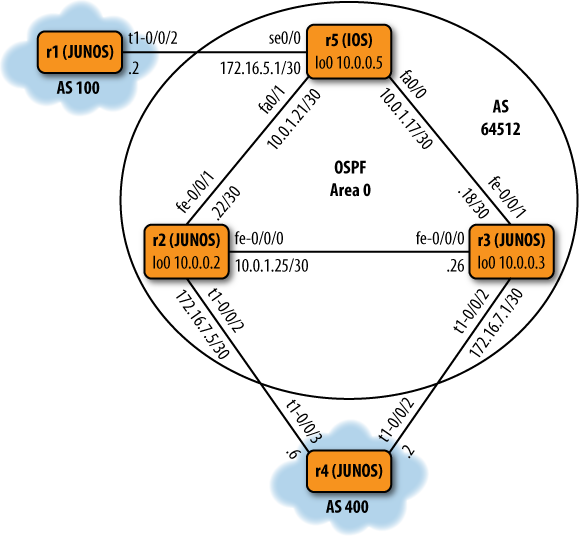Routing Protocol Interoperability
Figure 15-5 illustrates a few issues you may encounter when running common industry-standard routing protocols among Juniper and Cisco routers. In this figure, devices from different vendors have been mixed in a rather haphazard way to trigger certain issues that we want to address. The figure does not necessarily reflect a layered or site-based approach to multivendor networks.

Figure 15-5. Base topology for IGP and BGP interoperability concerns
In Figure 15-5,
routers r2, r3, and r5 share OSPF adjacencies, which use MD5
authentication, and Internal BGP (IBGP) relationships within AS 64512.
Router r5 is an External BGP (EBGP)
peer to r1 in AS 100. Routers r2 and r3 are
EBGP peers to r4 in AS 400.
In this example, we assume that AS 64512 contains other Cisco
devices that are connected in a partial mesh. Router r5 represents the collection of Cisco
routers.
Interface Connectivity
Before bringing up OSPF or BGP relationships among the Cisco and
Juniper devices, we must first establish simple Layer 3 connectivity.
Assuming that all physical cabling is in place, we add the necessary
configuration elements for the Cisco–Juniper connections on r5. This snippet shows Fast Ethernet
interfaces 0/0 and 0/1 configured with appropriate IP addresses
for connectivity to r3 and r2. We also see the appropriate address for
serial interface 0/0 and confirm that a loopback ...
Get JUNOS High Availability now with the O’Reilly learning platform.
O’Reilly members experience books, live events, courses curated by job role, and more from O’Reilly and nearly 200 top publishers.

